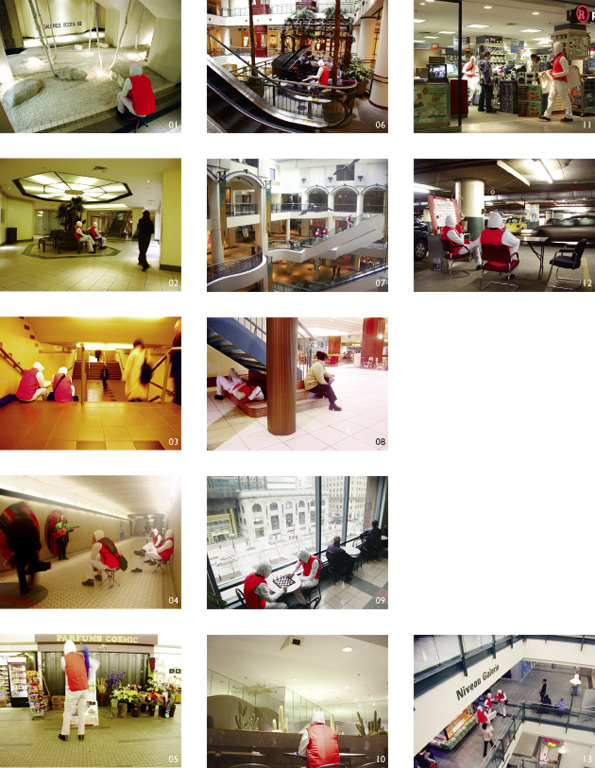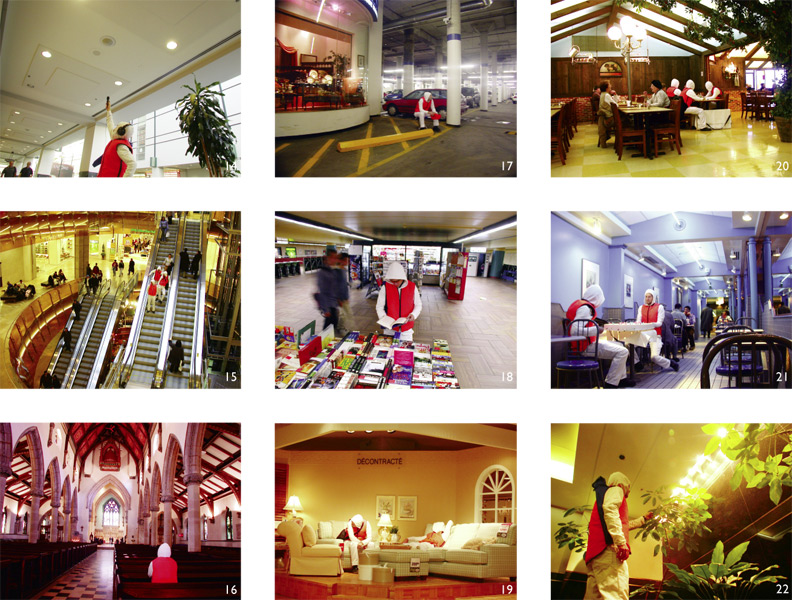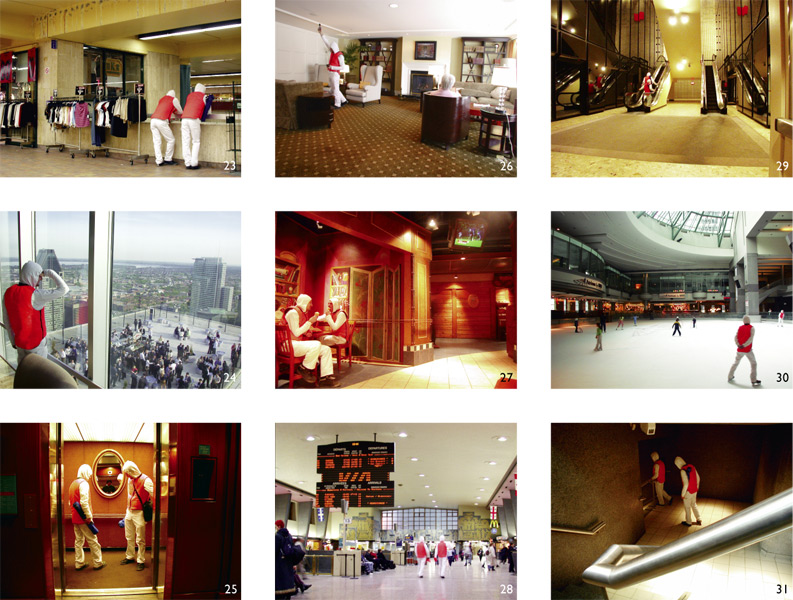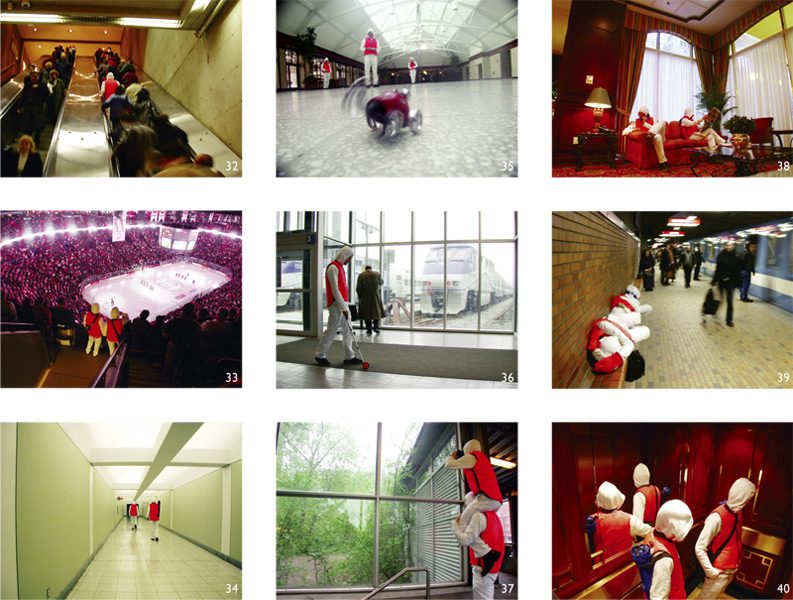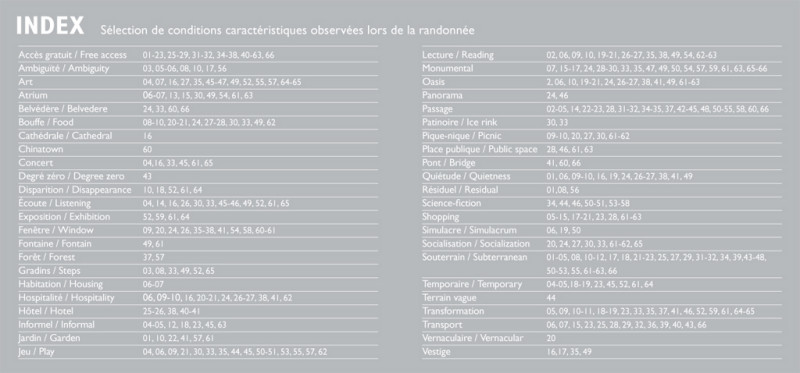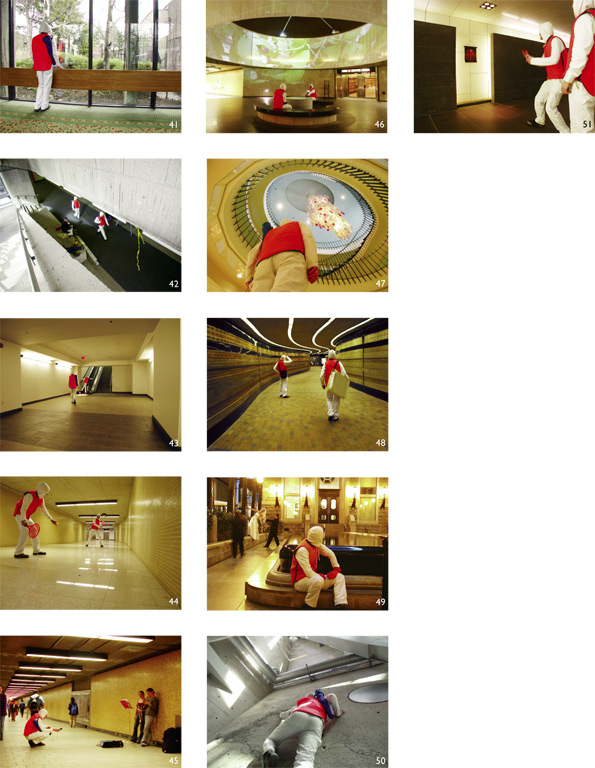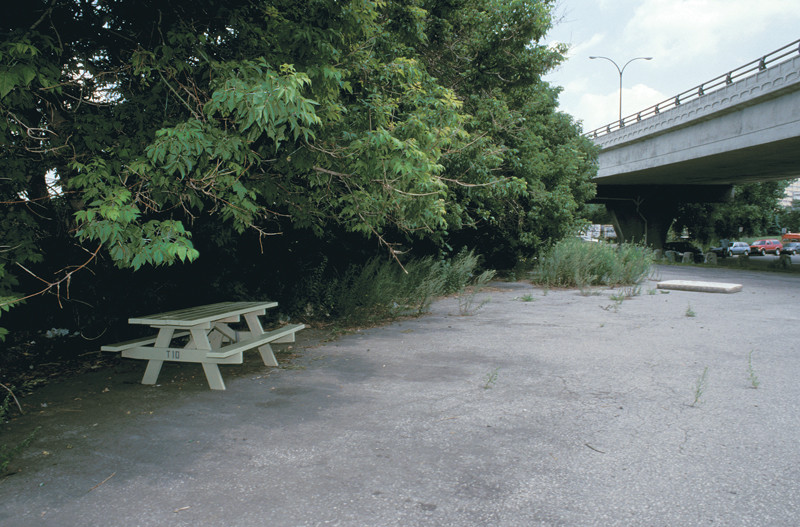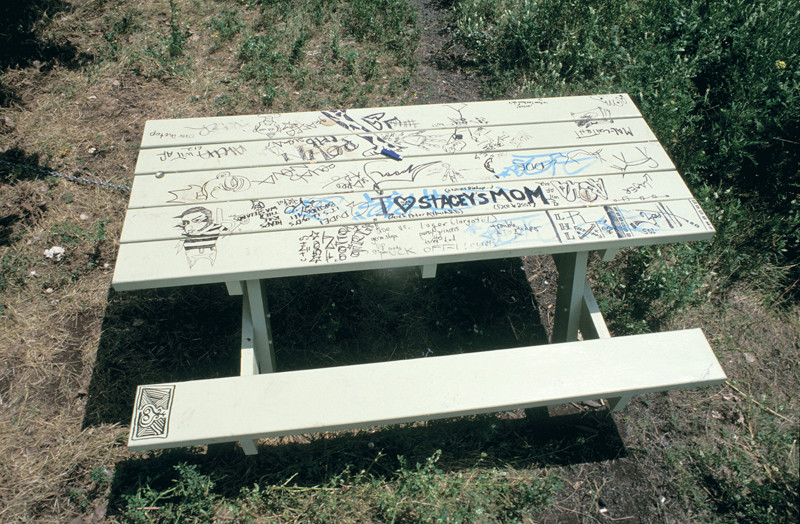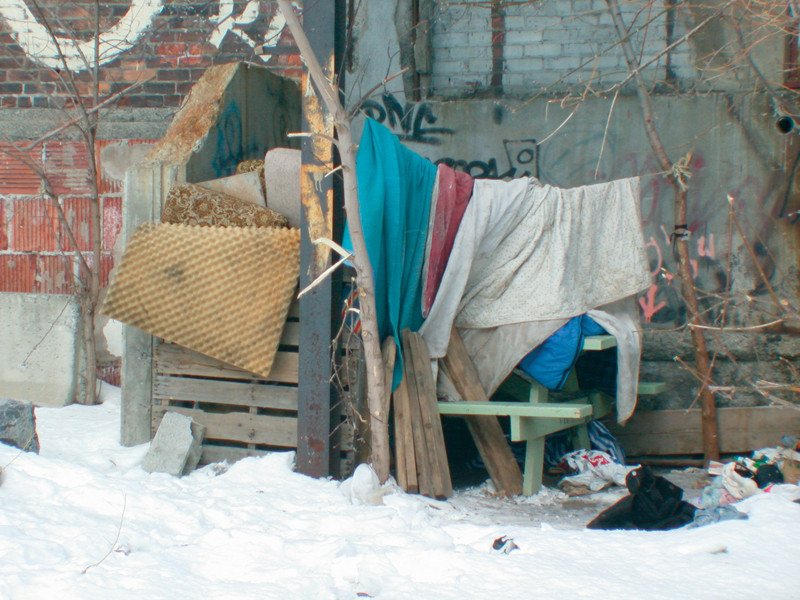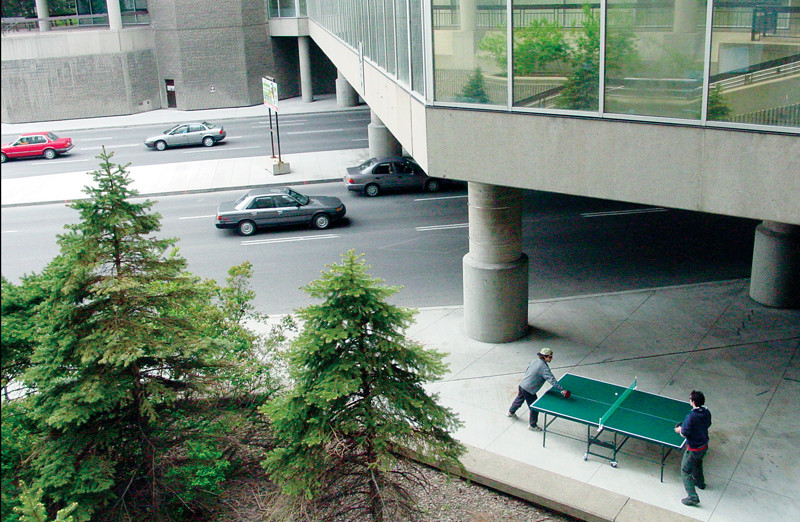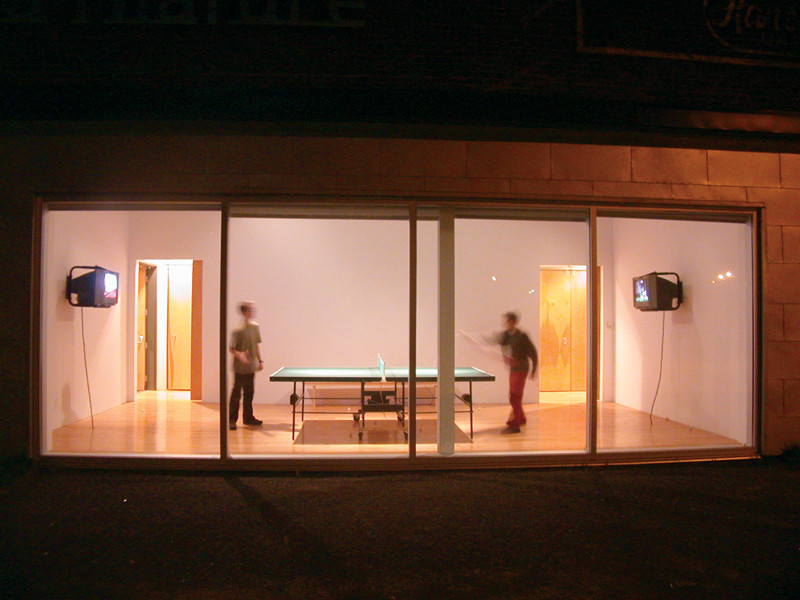[Fall 2005]
By Johanne Sloan
SYN–’s Prospectus (2003–04)1 points to contradictions in the relationship between contemporary artists and the city. This sequence of eighty-one photographs shows the SYN– members wandering around and engaged in play at various locations in the “hyperbuilding” otherwise known as Montreal’s underground city.
Their sensibility might be akin to that of the surrealists and the situationists, and also to that emblematic observer of the modern city, the flâneur. It is not possible, however, to regard SYN’s– project solely within this aesthetic tradition, in which the artist’s subjectivized experience creates a counter-reality to the commodified spectacle of the city. This is because the SYN– pseudo-flâneurs are clad all in white with orange safety vests, while the “city” in question consists primarily of the interior space of corporate and commercial Montreal; also, the photographs of the artists “at play” are presented to us as imagery resembling that which is captured every day by surveillance cameras. All of this suggests a high degree of control and institutionalization. The uniform-like clothing, in particular, serves to locate the SYN– figures alongside the security guards and maintenance workers who assume custodial duties in relation to this interiorized cityscape. Some years ago, Jeff Wall created a character wearing a fictitious “Office of the Stumbling Block” badge and uniform (in The Stumbling Block, 1991), as if the municipal government had taken on the responsibility of creating obstacles for its citizenry. And so perhaps SYN–, in a similar fashion, has invented a cadre of unionized workers who are sent out by the city’s official Bureau de flânerie.
If the artists are indeed adrift in the underground city, it was Guy Debord who explained how the dérive (drift) could be a radical (situationist) practice within the city. “In a dérive one or more persons during a certain period drop their relations, their work and leisure activities, and all their other usual motives for movement and action, and let themselves be drawn by the attractions of the terrain and the encounters they find there.”2 While the entire city bears the imprint of political and economic forces, Debord argued that it was possible, with such practices, for individuals to respond to unexpected spaces (interstices), objects, and gestures. These encounters are meant to serve as triggers for an imaginative transformation of the urban environment; thus the reified city comes back to life. In certain ways, the situationist project seems to have inspired Prospectus: Debord described the necessary suspension of work, and indeed SYN–’s curious costumes suggest that some job is meant to be performed, even while the “workers” are playing games with rackets and balls, or have simply ceased all activity and are apparently idling away the time or lost in a contemplative state. These actions must be read as “not-work” or “anti-work,” inserted into a work environment.
As viewers of these images, we might choose to identify with the artists’ mild transgressions in the underground city, but our visual access to these performances is due to an elevated, omniscient gaze embodied in the photographs. Orchestrating this project, the SYN– members have taken on dual roles – performing their dérives or flânerie at ground level, and also occupying a position of surveillance vis-à-vis these activities. Certainly the SYN– members’ bright plumage ensures that they will stand out and be immediately locatable to the people (whoever these might be) manning the inevitable surveillance cameras. One of the effects of Prospectus, then, is to make us aware that the “public” space of the hyperbuilding is characterized by its super-visibility. There is nowhere to hide in the twenty-first-century city: this message went out to the world after the London bombings of July 2005, when everyone could immediately see the faces of suspects caught by the thousands of cameras positioned within the city. What happens to all this footage? Will all the daily recordings of every city’s comings and goings be stored somewhere, in some sort of enormous visual archive of urban space under threat?
SYN–’s Prospectus, in acknowledging this visual episteme, suggests a darker, more dystopian view of urban experience than was implied in earlier projects such as Hypothèses d’amarrages (2000) and Hypothèses d’insertions (2002). These works had attempted to locate and activate “interstices” within the otherwise repressive or regimented narratives of city life. In the first instance, ordinary picnic tables placed in vacant lots, beside highways, or under bridges were quickly used and symbolically appropriated by Montrealers; the inserted tables thus became a way of framing genuine, everyday social interaction. But there is no equivalent opportunity for meaningful social interaction in Prospectus; the SYN– figures move alongside the urban crowd, singly or in pairs, but they are markedly different, and they fraternize only with each other. Hypothèses d’insertions involved the insertion of ping-pong tables in unlikely locations around the Hull area, and here, too, the unusual sites were illuminated through this artistic gesture. In both earlier projects, the photographic documentation of the artworks took the form of postcards, showing a nocturnal ping-pong game on the roof of a parking garage, for instance, or a table set up in the shadow of stately civic architecture. These postcards convincingly demarcate a poetic or playful interlude in the workaday life of the city, in a way that is dramatically different from the monitored and institutionalized “play” of Prospectus.
In their writings, SYN– members refer to the interior space of Prospectus as a “hyperbuilding” or “megastructure,” and indeed the megastructure concept has a strong Montreal connection. The architectural critic Rayner Banham wrote a book about megastructures that devoted a chapter to Montreal in the 1960s, which he described as “the capital city of megastructure in Expo year 1967.”3 Besides the Expo 67 site, this urban vision encompassed the Métro, the new indoor plazas and shopping malls, the large number of subterranean passageways, and other features that would eventually be identified as parts of the underground city. For the sixties generation, the megastructure was understood as a structural framework that allowed modular units within it to be continually rearranged. This experimental model was an attempt to infuse architecture with flexibility and spontaneity, challenging the tendency of cities to calcify into monumentality and ideological fixity. People would supposedly move through such spaces with a heightened responsiveness and a sense of pleasure and play. At the end of his Montreal chapter, Banham voiced the optimistic view that “some sort of full civic life could . . . be lived in totally artificial environments.”4
More recently, Rem Koolhaas has suggested that such environments – airports, shopping malls, offices, and all the agglomerations of interconnected and interiorized spaces that characterize much of the built world – can more accurately be termed “junkspace.” He states clearly, furthermore, that “architects thought of Junkspace first and named it Megastructure.”5Koolhaas’s description of living in junkspace is a kind of parodic inversion of the situationist dérive, because the aimless drift through endless interiorized space is no longer an emancipatory form of consciousness. In fact, Koolhaas actually talks about the “enforced dérives” characteristic of the contemporary built environment. The endless movements through incoherent spaces have now become “grotesque journeys.”6
Can we look to artists to interrupt the spatial consciousness of this interiorized urban environment? Can the corridors, vestibules, and between-spaces of the underground city become inspiring interstices? Or are the SYN– artists illustrating the kind of “enforced dérive” now programmed into everyday urban experience? There are a few photographs in the Prospectus sequence that suggest an alternative to the relentless interiority of the underground city. One of the SYN– figures stands at a window and looks outside, as if this inaccessible other world were worth dreaming about.
1 These photographs are drawn from a digital slideshow comprising over 1,500 images chronicling the spaces and ambient sounds encountered within the hyperbuilding. This installation was set up in the Canadian Centre for Architecture Vitrine in one of the underground city’s pedestrian passageways (see image 52, page 11).
2 Guy Debord, “Theory of the Dérive,” translated by Ken Knabb. Internet site:
http://www.socialfiction.org/derive.htm. (Originally published in Internationale Situationniste, No. 2, December 1958.)
3 Reyner Banham, Megastructure: Urban Futures of the Recent Past (London: Thames and Hudson, 1976), p. 105.
4 Ibid., p. 127.
5 Rem Koolhaas, “Junkspace,” October, No. 100 (Spring 2002): 178.
6 Ibid., p. 181.
SYN– atelier d’exploration urbaine was created in 2000 by architect Luc Lévesque and by artist and fellow architect Jean-François Prost. Jean-Maxime Dufresne, an artist with a background in architecture and in interactive media, and Louis-Charles Lasnier, a designer with a degree in architecture and graphic design, joined the collective in 2002 and 2003 respectively.
Johanne Sloan teaches art history at Concordia University. Her research interests include landscape art and aesthetics, as well as issues in public art and urban culture.
www.amarrages.com
This text is reproduced with the author’s permission. © Johanne Sloan.

